

Even though mechanical ventilation can save lives and be beneficial for subsequent operations, it may also harm human health sometimes. It’s crucial to pay attention to the use of specific mechanical ventilation based on the needs of different patients.
There are two main types of mechanical ventilation: negative pressure ventilation (NPV) and positive pressure ventilation (PPV)[1][2]. At present, positive pressure ventilation (PPV) is the primary choice for most patients in various situations due to its accessibility and safety.
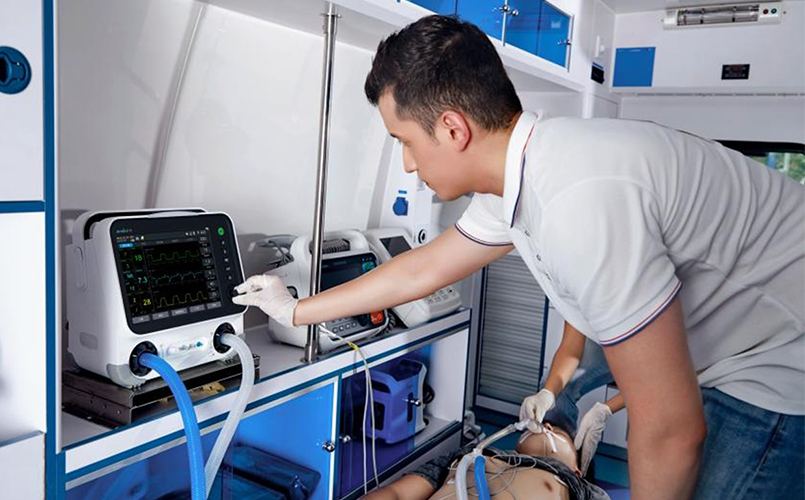
Rescue team uses Amoul®T6 to save a male patient from danger.
What are the two main types of mechanical ventilation?
Negative pressure ventilation (NPV) is defined as the primal mode of mechanical ventilation generated from outside of a patient’s body in an enclosed environment such as an iron lung. The outside air is pulled compulsively into the patient’s lung, because of the air pressure difference between the two segregated environments. More specifically, the patient’s body is isolated in an air-tight chamber or elongated tank except for his/her head, then it creates a lower air pressure inside this closed space relative to the outside environment and prevents
contaminated air to escape from this negative pressure space, the negative pressure results in expanding the chest that decreases\
intrapulmonary pressure to move the air into the lung [2]. We call the this kind of machine that could deliver negative pressure ventilation iron lung.
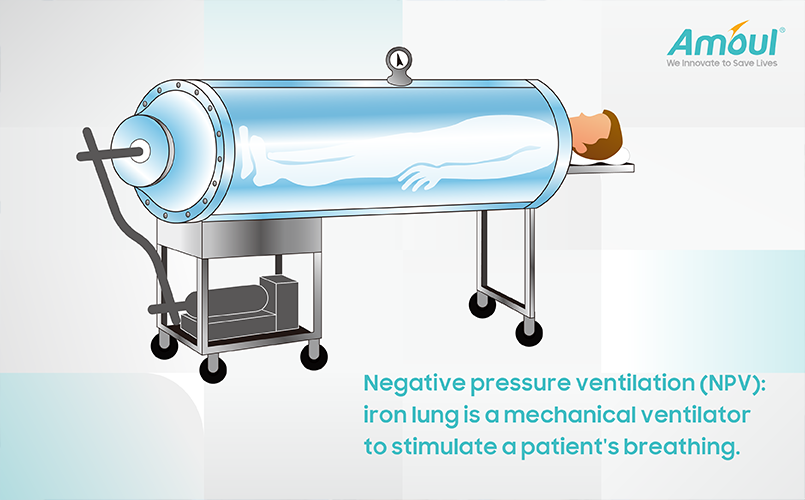
Negative Pressure Ventilation (NPV)
Positive pressure ventilation (PPV) is a more safe and more modern treatment based on technical developments by the military during World War II[2]. It’s integrated into a machine or device in a compact size that forces mechanically the air, or a mixture of oxygen combined with other gases into the central airway so that the alveolar pressure increases, and the lung inflate where the elastic recoil allows
exhalation smoothly.
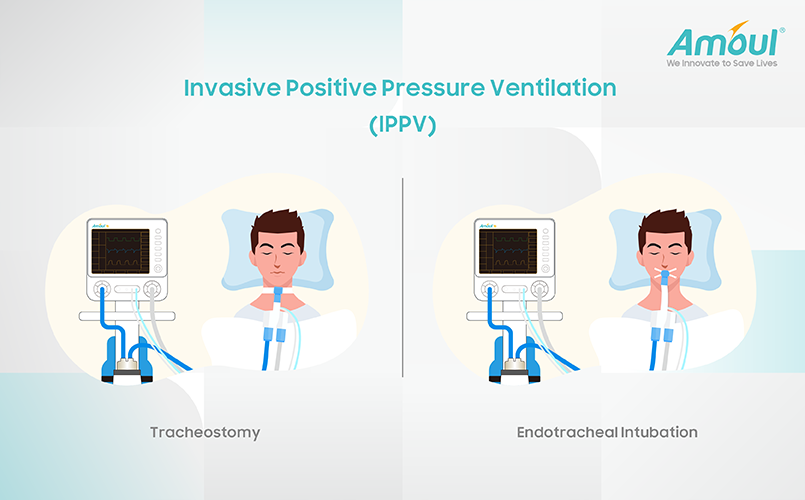
Invasive Positive Pressure Ventilation (IPPV)
A positive pressure ventilation system can be delivered in two ways: through the use of a face mask, nasal mask, or helmet, called non-invasive positive pressure ventilation (NIPPV), or by using an endotracheal intubation or tracheostomy, which provides breathing support by pushing air through the mouth or throat of the patient.
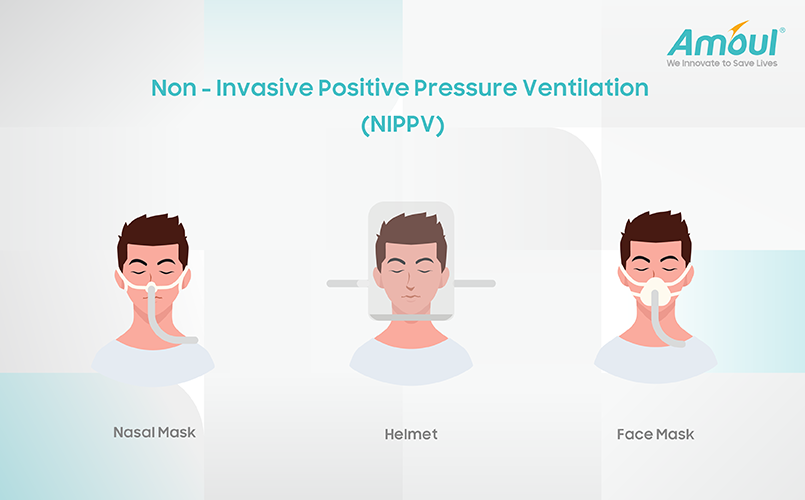
Non - Invasive Positive Pressure Ventilation (NIPPV)
In which situations do we use mechanical ventilation?
In the human body, oxygen helps convert energy, and building the immune system allows the body to function normally. It is vital that we breathe in order to ensure that oxygen reaches our cells and that carbon dioxide is released as waste gases [3].
Mechanical ventilation is needed for some patients with respiratory failure or breathing difficulties in order to get an adequate supply of oxygen and remove carbon dioxide without injury to the lungs, as well as to lessen respiratory muscle fatigue.
There are a few common reasons why patients require mechanical ventilation to assist or maintain their respiration [4]:
- Acute respiratory distress syndrome (ARDS): It’s a severe lung injury that occurs when fluids fill up the air sacs (alveoli) in the lungs, preventing oxygen from reaching the organs.
- Heart failure: It’s known as cognitive heart failure, it occurs when the heart muscle is an inability to pump enough blood and receive oxygen-rich blood from the lungs.
- Pneumonia: It’s an infectious disease of the lower respiratory tract that inflames the air sac in one or both lungs with bacteria, viruses, fungi, or chemical irritants.
- Sepsis: It’s a serious infection occurs when bacteria produce toxins that cause the immune system to attack the body's own tissues and organs.
- Trauma: It's an emotional response to a terrible event such as an accident, rape, or natural disaster, which requires supplemental oxygen to enhance metabolism and cellular health.
- Sleep apnea: It’s a sleep-related breathing disorder that occurs when the throat muscles relax too much during sleep, which may result in serious health problems such as high blood pressure and heart trouble.
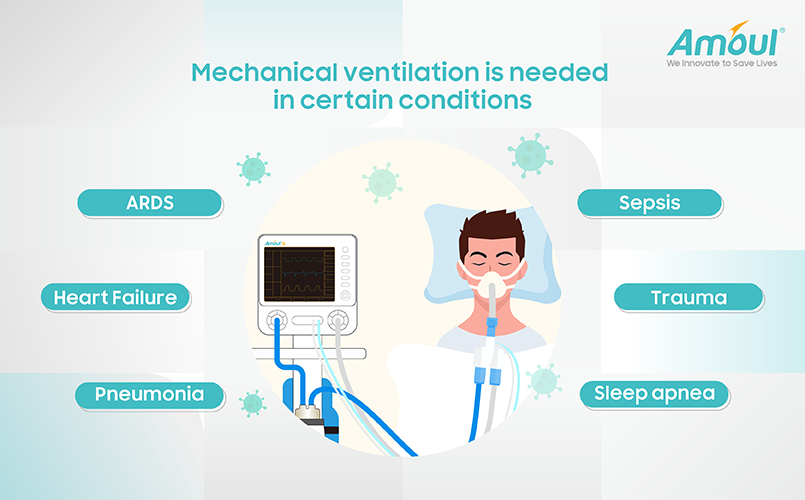
Mechanical ventilation is needed in certain conditions
What are the benefits of using mechanical ventilation?
For patients with breathing difficulties, mechanical ventilation demonstrates the following benefits[4]:
- Decreases the workload and energy of each breath, and relieves respiratory distress.
- Recovers normal breathing by maintaining adequate oxygenation.
- Increases respiratory rate or tidal volume for clearing carbon dioxide.
- Maintains a stable airway and prevents aspiration injuries, enabling medications and other therapies to take effect.
What are the risks of using mechanical ventilation?
There are two main reasons why mechanical ventilation may cause serious outcomes in patients [5]:
- Respiratory infections: Ventilator-associated respiratory infection (VARI) appears frequently in people who receive mechanical ventilation in intensive care units (ICUs), which includes ventilator-associated pneumonia (VAP) and ventilator-associated tracheobronchitis (VAT) since the bacteria enter the lungs through breathing tubes during mechanical ventilation [6].
- Lung damage: There is an increase in morbidity and mortality associated with ventilator-induced lung injury (VILI) caused by high airway pressures and large tidal volumes [7]. In addition, it may lead to complications such as pulmonary edema, barotrauma, and worsening hypoxia, thereby extending the duration of mechanical ventilation.
Innovative mechanical ventilation solution
We developed our turbine-driven mechanical ventilator as a better solution for respiratory failure patients such as COVID-19, ARDS, COPD patients, and etc. With our advanced turbine technology, patients could be given constant breathing support quietly wherever and whenever they want.
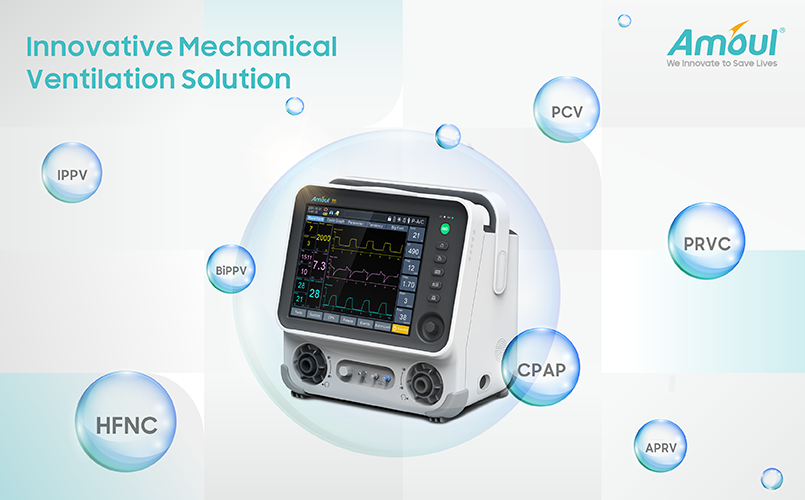
Innovative mechanical ventilation solution on Amoul®T6 ventilator
The Amoul®T6 ventilator offers exclusive features that can be adjusted to meet the needs of diverse patient groups.
For exemple:
- P-V tool : Integrated into T6 is an assistant tool for doctor and other medical personnel to adopt an appropriate lung recruitment strategy and adjust the PEEP setting to deliver safely ventilation.
- Suctioning maneuver: This device has instructions on the screen that help you complete the suction maneuver easily, which improves ventilation efficacy and ensures the patient's safety at the same time.
- HFNC mode: HFNC provides a high fraction of inspired oxygen (FiO2) and low-level positive pressure with washout of nasopharyngeal dead space for the patient's comfort and safety.
Conclusion
A modern mechanical ventilation system with smart technology can enhance the survival rate of patients by offering more accurate solutions for specific circumstances. Despite the ongoing innovations in mechanical ventilation, there is still a significant potential for improvement to adapt to actual market needs and requirements.
1. The mechanical ventilator: past, present, and future. Robert M Kacmarek. August 01, 2011.
Available at: https://pubmed.ncbi.nlm.nih.gov/21801579/
2. History of mechanical ventilation. From vesalius to ventilator-induced lung injury.
Available at: https://www.atsjournals.org/doi/10.1164/rccm.201503-0421PP
3. How your lungs work? British lung foundation
Available at: https://www.blf.org.uk/sites/default/files/how%20your%20lungs%20work%20v4.pdf
4. Principles and practice of mechanical ventilation, third edition. Martin Tobin. November 13, 2012.
5. Mechanical Ventilation. Patient Education. Information Series. American Thoracic Society
Available at: https://www.thoracic.org/patients/patient-resources/resources/mechanical-ventilation.pdf
6. Suspected ventilator-associated respiratory infection in severely ill patients: a prospective observational study. Jason Shahin; Michael Bielinski; Celine Guichon; Catherine Flemming and Arnold S Kristol. October 22, 2013.
Available at: https://www.ncbi.nlm.nih.gov/pmc/articles/PMC4056611/
7. Ventilator-Induced Lung Injury (VILI). June 19, 2022. Ajith Kumar; Fatima Anjum.
Available at: https://www.ncbi.nlm.nih.gov/books/NBK563244/